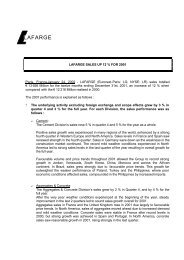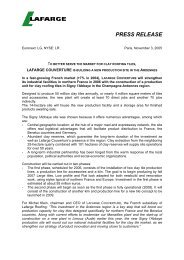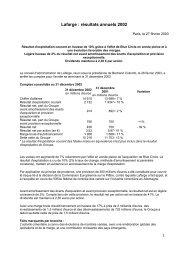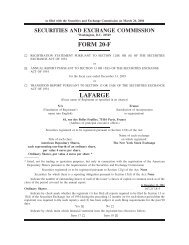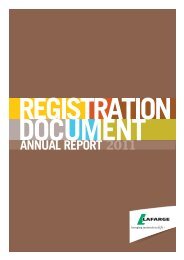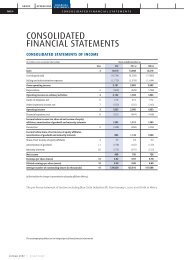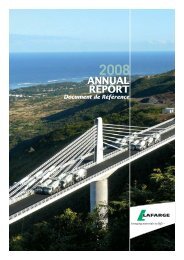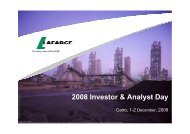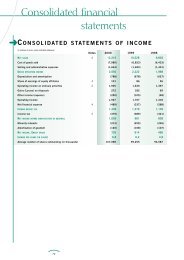2005 Sustainability Report - Lafarge
2005 Sustainability Report - Lafarge
2005 Sustainability Report - Lafarge
You also want an ePaper? Increase the reach of your titles
YUMPU automatically turns print PDFs into web optimized ePapers that Google loves.
Protecting the environment<br />
Protecting surroundings<br />
and reducing<br />
local nuisances<br />
At the local level, cement production gives rise to various emissions<br />
such as dust, nitrogen oxides (NOx), sulfur dioxide (SO2)…<br />
Our emissions are continuously reduced through enhancements<br />
to production processes. Even though these reductions often incur heavy<br />
costs, we systematically take action to control and reduce our emissions.<br />
We conform to the local regulatory requirements in all cases, and attempt<br />
to go even further.<br />
CONTROLLING LOCAL<br />
AIR EMISSIONS<br />
Controlling and monitoring<br />
emissions<br />
Our objective is to cap dust emissions<br />
at a maximum of 50 mg/Nm 3 by 2010.<br />
Installing special equipment and<br />
developing specific techniques enabled<br />
us to achieve this target during <strong>2005</strong><br />
at 66% of our cement plants.<br />
> See indicators on page 41<br />
Specific programs implemented<br />
with WWF<br />
Persistent pollutants (such as dioxins,<br />
furans and heavy metals) may be found<br />
in inputs and emissions in cement<br />
plants. <strong>Lafarge</strong> has undertaken to<br />
improve its performance and has been<br />
working together with WWF since 2002<br />
on specific programs to reduce these<br />
emissions. In <strong>2005</strong>, <strong>Lafarge</strong> committed<br />
itself to registering priority facilities,<br />
elaborating best management practices,<br />
setting monitoring indicators and<br />
improvement objectives. In 2006,<br />
<strong>Lafarge</strong> will assess the inputs of the best<br />
PAGE 22 | <strong>2005</strong> SUSTAINABILITY REPORT | LAFARGE<br />
practices and apply them first at priority<br />
facilities and then at all its cement<br />
plants.<br />
More information about the specific program<br />
for mercury emissions is available<br />
on our website.<br />
REDUCING THE VISUAL<br />
IMPACT OF OUR PLANTS<br />
Mindful of the importance of the<br />
visual impact of its sites for the local<br />
communities, the Cement business<br />
worked with an architect in <strong>2005</strong> on the<br />
design of an internal survey. Its goal<br />
is to assess the importance placed on<br />
this issue by plant managers and to<br />
establish a benchmark for improving<br />
the visual integration of facilities. To<br />
date, 70% of plants have carried out<br />
their self-assessment based on the<br />
benchmark. In addition, as planned in<br />
2004, Cement's Advance performance<br />
program now includes a “visual impact”<br />
component. Subsequently, <strong>Lafarge</strong> will<br />
identify and establish formal best<br />
practices to be implemented for all new<br />
plants.<br />
Restyling project<br />
of <strong>Lafarge</strong> cement<br />
plant in Fuhais,<br />
in Jordan,<br />
by Bogaert agency.<br />
LAFARGE / WWF PROGRAM<br />
ON PERSISTENT<br />
POLLUTANTS<br />
As part of our work programs with WWF,<br />
we collaborate to find ways to reduce the<br />
emission of persistent pollutants from<br />
our cement factories.<br />
This collaboration led to a common view<br />
that we present here:<br />
“<strong>Lafarge</strong> is committed to setting an example<br />
concerning management of persistent<br />
pollutants. <strong>Lafarge</strong> commits itself to<br />
improving its performance and in particular<br />
to reducing its emissions of persistent<br />
pollutants through an efficient management<br />
of the whole production process.”<br />
Many of our stakeholders worldwide<br />
have shown an interest on this topic.<br />
Moreover, this concern is tackled by<br />
the WBCSD CSI.




